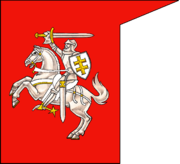White Ruthenia
|
|
White Ruthenia (White Russia) is a name that was historically applied to different regions in Eastern Europe, most often to the region that roughly corresponds to the present-day Belarus. Many languages today continue to use this obsolete name when referring to Belarus — especially Germanic languages ("Weißrussland" in German, "Wit-Rusland" in Dutch, "Vitryssland" in Swedish) and some other languages ("Baltarusija" in Lithuanian, "Λευκορωσία" in Greek). Because of its association with perceived Russian and Soviet imperialism, some consider the name derogatory.
| Contents |
The meaning of the name and its translation
The name "White Russia" is a literal, although not entirely correct translation of the names Belaya Rus (Белая Русь) and Belorussiya from Russian. The problem with this translation is that the name "White Russia" seems to suggest that this territory is related to the present-day Russian Federation, whereas it is related to the ancient lands of Ruthenia (or Rus’—see also Etymology of Rus and derivatives).
Ruthenia is a latinized name of Kievan Rus’, a 9th to 12th-century state and its descendents, which existed in the territories of modern-day Belarus, Ukraine, and portions of western Russia, eastern Poland and Slovakia.
Although Belarus translates to White Russia in many modern languages for historic reasons, the equation of Rus’ and Russia is controversial today. Many Belarusians rankle at its implications on their national self-determination, particularly in light of imperial Russian and Soviet rhetoric calling for the reunification of "one indivisible Russia".
Conversely, in some languages there is a clear distinction between the two words. For example:
- Polish: Białoruś (White Rus), but Rosja (Russia);
- Ukrainian: Білорусь Bilorus (White Rus), but Росія Rosia (Russia);
- German before 1945: Weißruthenien (White Rus), but Russland (Russia).
History
Many other variants of this name appeared in ancient maps: for instance, Russia Alba, Russija Alba, Wit Rusland, Weiss Reussen, White Russia, Weiss Russland, Ruthenia Alba, Ruthenie Blanche and Weiss Ruthenien (Weißruthenien), assigned to various territories, often quite distant from that of present Belarus. For example, at one time the term was applied to Novgorod.
Only by the late 16th century did it become a name for the area of the present Belarus. Until this time and for a long time afterwards the population of this territory (Belarusians) were known as Litvins (i.e., Lithuanians), by the name of the Grand Duchy of Lithuania, to which the land belonged since the 12th century.
White colour was traditionally perceived by Slavic people as the colour of freedom. According to the great philologist Potebnya, the epithet came to be applied to Ruthenian territories that haven't been occupied by the Tatars after the Mongol invasion of Russia. Thus, "White Ruthenia" may stand for "Free Ruthenia". Most scholars agree, however, that the epithet alludes to white clothes and blond hair of Belarusian population.
As the time went by, the Russian tsar started to be called a "Great White Tsar". At last Ivan III included among his official titles the style (literal translation): "The Sovereign of all Rus': the Great, the Little, and the the White". According to some scholars, the word "bely" in this title actually alludes to the fortress of Bely, which marked the border of Muscovy and Poland. Whatever the truth may be, this appellation, together with the solemn wording "White Tsardom", was in limited use till the very end of the Russian Empire. Ultimately, this colour was transferred onto the name of the counter-revolutionary White Army that fought against the Red Army.
It still remains unclear how the name "White Russia" has ultimately become applied to Belarus. It is noteworthy that some other peoples have been referred to by colour. There have been White Serbs and White Croats. In China Red, Black, and Green Miao are known.
Related articles
- Etymology of Rus and derivatives
- Great Russia
- Little Russia
- Ruthenia
- White Russians (Russian Civil War) (this old-Russia-wide notion is unrelated to the topic of this article)
External links
- The 21 Names of Belarus (http://www.pravapis.org/art_belarus_name.asp)
- Why is the Russia White? (http://www.pravapis.org/art_white_russia.asp)be:Белая Русь

